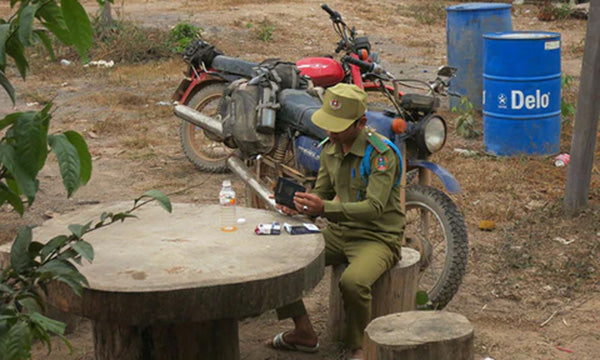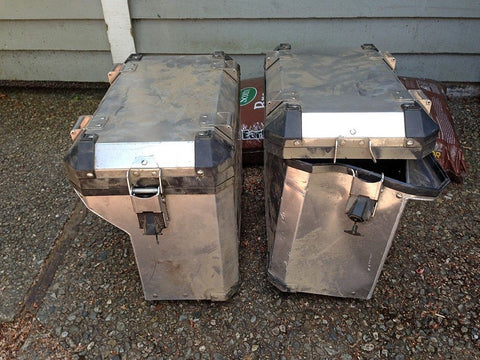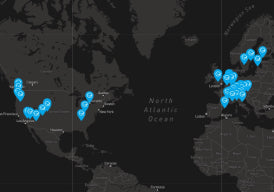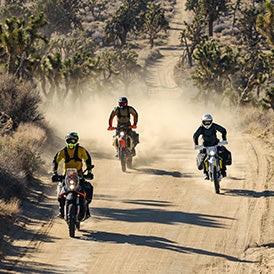Your Cart is Empty
Luggage
Apparel
events
The Mosko Blog
Soft Luggage Security
April 12, 2022

If you travel enough you will eventually experience theft. It sucks but it comes with the territory.
I’ve traveled all over the world on motorcycles using both soft luggage and hard luggage. I’ve been pick-pocketed and mugged. I’ve had a motorcycle stolen. I’ve been shaken-down by police and soldiers more times than I can count, and like any international traveler, I’ve paid my share of bribes. One thing I’ve never experienced is having anything stolen off my bike. Probably due to luck more than anything. It’ll happen at some point.

Police Shakedown, Laos, 2015
Fear of theft causes a lot of angst for motorcycle travelers. If you’re feeling it, you are not alone.
Many new riders start with hard luggage when they first get into adventure riding. Security is one of their primary concerns. Big aluminum boxes look tough, and because of that, they provide a visible theft deterrent. In reality though, with the right tools and a little privacy, it’s remarkably easy to get into any kind of pannier, hard or soft, locked or unlocked. No lock will stop a determined thief if they have the time and space to work. If you want to get really uncomfortable, watch some YouTube videos on motorcycle theft. It only takes a few seconds to lift your entire bike and throw it in the back of a van, luggage and all.
Given that, the goals of a luggage lock are simply to keep honest people honest, provide a visible deterrent to a potential thief, and make sure that anyone trying to steal your stuff has to cause a commotion to get it.
Here are a few thoughts:
It’s a good strategy to keep critical items – like your passport, wallet, phone, bike documents, cash, and camera – somewhere intentional. For example, carry them on your person, or in a tank bag that you always pop off the bike and carry with you. You can still get robbed – for example, if somebody jumps you - but it’s less likely than if those items were unattended on your bike.

Store important items in your tank bag, and take it with you.
Hard luggage is only secure if the latches and locks are in good working order. If you’ve been riding a lot of dirt, and your latches are broken and/or your panniers are being held on the bike with ratchet straps, then not only is that a total hassle for the rest of your trip, but also your panniers are not secure. You would have been better off with some soft panniers and locking straps.

Trashed hard panniers are not secure.
Unless you’re living on your bike full time, getting soft luggage doesn’t mean you have to give up your hard luggage. It’s not an ‘either/or’ decision, many riders have both. They use hard luggage for commuting and urban riding, and soft luggage for riding offroad.
With soft luggage, many people worry about bag-slashing. I’ve never seen or heard of one of our soft panniers being cut with a knife, except the one I slashed myself because I wanted to see how hard it was. Besides having multiple layers of heavy duty, abrasion-resistant materials, there are also plastic stiffeners, foam, and external pockets to contend with. It takes a lot of sawing to get in, and you’d be hard pressed to remove something as large as a sleeping bag or camp stove before someone stops you.
‘Snatch and grab’ is a bigger risk than bag-slashing. Although it hasn’t happened to me personally, I’ve met people who’ve lost tank bags, duffles, and panniers (both hard and soft) to theft. In every single case, the theft occurred when they left their bags unattended and unlocked, sometimes sitting overnight outside a hotel. Obviously, if you leave your belongings unattended and don’t take precautions, they may not be there when you get back.
With moto luggage compared to, say, a backpack or purse, it helps that not everyone intuitively knows how to open a roll-top, side-release buckle, or rotary draw latch. The few seconds it takes to figure that out can sometimes be enough to prevent a theft. My buddy and I were at the Ghana/Togo border a few years ago. People were pressed in all around our bikes, and a bunch of sketchy touts were hassling us non-stop for money changing, hotels, and all sorts of stuff. We went in the customs office for a few minutes, and even though we watched our bikes the entire time, someone still managed to surreptitiously open a few buckles. I have no idea how they accomplished that, but they must have given up because they couldn’t open the roll-top without us seeing.

Lome, on the Togo side of the border
Another time in Chile, two guys grabbed my backpack when it was loosely draped over one shoulder. After some violent tug-of-war I kept my bag, just barely. I had screwed up and wandered into a crappy part of town without paying attention. There was nobody around to help. Those two guys chased me for several blocks before I jumped in a passing minivan that slowed down to pick me up. I was lucky to get away with my stuff and no cuts. If you unwittingly parked a bike in that same neighborhood and walked away, I think it’s safe to assume there would be nothing left when you returned. No bike, no bags, nothing.

A pic I snapped just a few minutes before two dudes tried to grab my bag in Valparaiso, Chile
The best way to stop snatch and grab theft is always to keep an eye on your bike and use a visible lock to deter a thief before they get close. If you must walk away, park near honest people who are likely to intervene if someone pulls out a crowbar or cable cutters. Nobody likes a thief. That’s true all over the world. In some areas, if a thief is caught in the act, the locals will deal with him right there on the spot before the police have a chance to intervene.
If you’re in a developed country at a big-box store, park at the front of the lot and directly under the store’s security camera.
In the developing world:
- In markets: park near a food stall and ask the owner to watch your bike.
- At banks and stores: there’s usually a guard, ask them to watch your bike and tip them when you leave.
- At roadside restaurants: park where you can see the bike from your table.
- At tourist attractions: remove your luggage and put it in the guard shack. Tip the guards.
Remember: a determined thief will always get into your luggage – hard or soft, locked or unlocked - if they have the tools and a few moments of privacy. Don’t let them have the privacy.
If you’re using soft luggage, there are many innovative ways to lock it. Steelcore locking straps are great, and the lock is very large and visible. We’ve also seen riders using Pacsafe products: they’re tough and versatile, although somewhat more cumbersome to use. Try to find a security solution that not only locks the bag to the bike, but also locks the bag closed. If your bags use zippers, zipper-pullers can be locked together with a small padlock just like on a rollaboard. If your bags have roll-tops, they can be cinch-locked closed with a sliding lock like on the Steelcore straps or the Masterlock Python.

Steelcore Locking Strap
Try to find something that clearly states ‘this bag will take some effort to steal.’
Whether you choose hard panniers or soft panniers, don’t let the fear of theft – or an actual theft - drag you down while traveling. Yes, it could happen. If you travel enough, it probably will. Like with so many things, the worrying is often the worst part. There are plenty of resourceful and determined thieves in the world, and if they want your stuff, they’ll get it. You won’t be the first person to lose a passport, camera, laptop, phone, wallet, tent, or tools while traveling. You’ll still have an epic trip.
If you drove an armored tank around the world, it too could get stolen. Watch your bike, lock your bags, get out there and have a blast!
Braaap,
Pete
1 Response
Leave a comment
Comments will be approved before showing up.
Warranty and Crash Replacement
We never cut corners during development or manufacturing, so we stand behind our products. If one fails due to a problem with materials or workmanship, we’ll make it right.
Your are successfully subscribed for email notifications.
Notify me when available
We will send you a notification as soon as this product is available again.
Your email is required
We don't share your email with anybody
x









Jay Hughes
June 06, 2022
I have a GIVI rear panier made of heavy duty plastic. To create the impression it is just full of clothing I always a small bit of a rain cape hanging out of where the lid meets the base. Makes people think it’s just got junk it the pannier.
———
Mosko Moto replied:
Great tactic, Jay!